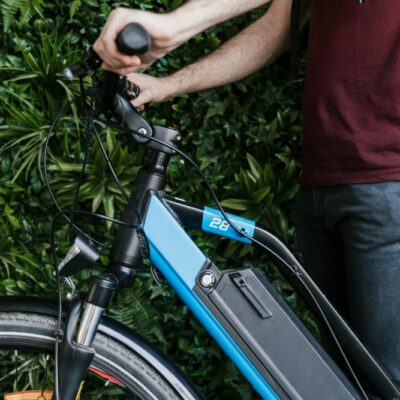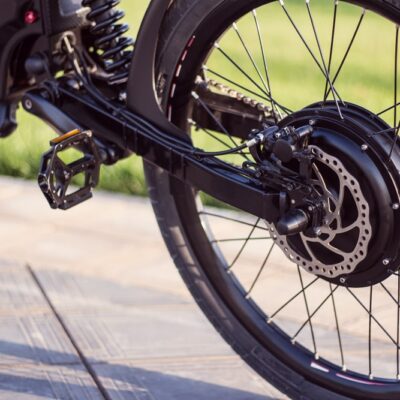Do you own an e-bike or are planning to invest in one? We know that how exciting it can be to ride an e-bike, however, safety should always be your top priority while riding any type of bike. E-bikes have become increasingly popular over the years due to their convenience and environmental benefits. They are easy to ride, affordable, and require minimal maintenance. But just like any other vehicle, e-bikes come with their own set of risks if not used properly.
Yes, e-bikes are fun to ride but understanding the safety measures is crucial to ensure a safe and enjoyable experience. That’s why we have put together 7 safety tips for e-bike riders to help you stay safe on the road.
1. Wear a Helmet
The first and most important rule of riding an e-bike is to always wear a helmet. Helmets are designed to protect your head from any impact or injury in case of an accident. Make sure you invest in a good quality helmet that fits properly and meets safety standards. Wearing a helmet can greatly reduce the risk of serious head injuries and can save your life.
It is also important to regularly check your helmet for any cracks or damage. If you have been in an accident, it is recommended to replace your helmet even if there are no visible signs of damage. Helmets are a crucial safety measure and should never be overlooked when riding an e-bike.
2. Follow Traffic Laws
Just like with any other vehicle, it is important for e-bike riders to follow traffic laws and regulations. This includes stopping at stop signs, obeying traffic signals, and riding in the designated bike lanes. It is also important to ride with the flow of traffic and not against it.
Be aware of your surroundings and use hand signals to indicate when turning or changing lanes. Remember that you are sharing the road with other vehicles and pedestrians, so always be cautious and ride responsibly.
Additionally, some cities and states have specific laws regarding e-bikes, such as speed limits or required safety equipment. Make sure to familiarize yourself with these laws to ensure you are riding safely and legally.
3. Inspect Your E-Bike Regularly
Before every ride, it is important to inspect your e-bike for any potential issues. Check the tires, brakes, lights, and battery to ensure everything is in proper working condition. If you notice any problems, have them fixed before riding. Neglecting regular maintenance can not only put you at risk but also lead to costly repairs.
It is also recommended to have your e-bike professionally serviced at least once a year. This will help identify any underlying issues and keep your bike running smoothly and safely.
You should also clean your e-bike regularly, especially after riding in wet or muddy conditions. This will not only keep your bike looking good but also prevent corrosion and damage to the components.
4. Be Mindful of Your Speed
E-bikes can reach higher speeds than traditional bikes, which can be both a pro and a con. While it may be tempting to go faster, it is important to be mindful of your speed, especially in crowded areas or on busy roads.
Always adjust your speed according to the road conditions and traffic around you. Going too fast can make it difficult to control your e-bike and increase the risk of accidents. Remember to also use caution when going downhill, as your e-bike may pick up speed quickly.
Learn More: 5 Helpful Maintenance Tips for Your Electric Vehicle
5. Use Proper Riding Techniques
Proper riding techniques are crucial for e-bike riders, especially when navigating through traffic or challenging terrain. Always use both hands to grip the handlebars and keep your feet on the pedals.
When turning, lean your body in the direction you want to go and shift your weight towards the outside pedal. This will help you maintain balance and control while making a turn. When going downhill, avoid using your brakes too often as it can cause them to overheat and reduce their effectiveness. Instead, shift your weight back and use the rear brake to control your speed.
It’s also important to always be aware of your surroundings and anticipate potential hazards. This includes checking for cars, pedestrians, or obstacles in your path. Use hand signals to communicate with other riders or drivers and always follow traffic laws.
6. Stay Visible and Be Prepared for Weather Changes
E-bikes are generally equipped with lights, but it is important to make sure they are functioning properly before each ride. It is also recommended to invest in additional lighting or reflective gear, especially if you plan on riding at night.
Additionally, always be prepared for changes in weather conditions when riding your e-bike. Carry rain gear if there’s a chance of rain, wear layers for colder temperatures, and protect yourself from the sun with sunscreen and a hat. Being prepared for varying weather conditions will not only keep you safe but also make your ride more enjoyable.
7. Educate Yourself on E-Bike Safety
Lastly, it is important to educate yourself on e-bike safety. This includes understanding the features and capabilities of your specific e-bike, as well as basic bike safety principles. You can also take a safety course or join a local cycling group to learn from experienced riders.
It’s also important to keep up with any updates or changes in e-bike regulations and laws. By staying informed, you can ensure that you are riding safely and responsibly at all times.
My Personal Experience with E-Bike Safety
As an avid e-bike rider, I have encountered various situations on the road that have underscored the importance of these safety tips. One incident that stands out happened during my early days of e-biking. Excited by the newfound speed and ease of travel, I overlooked the crucial practice of regular bike inspections.
One day, while commuting to work, my front tire blew out unexpectedly, causing me to swerve dangerously into traffic. Fortunately, I managed to regain control, but that experience was a stark reminder of how essential it is to inspect my e-bike regularly.
Additionally, following traffic laws has been vital for my safety. In another instance, I found myself nearly colliding with a car that ran a red light. Because I was vigilant and obeying traffic signals, I was able to stop in time and avoid what could have been a severe accident.
These experiences have made me a more cautious and responsible rider, emphasizing the importance of wearing a helmet, maintaining my e-bike, and always being aware of my surroundings. E-bikes are a fantastic mode of transportation, but they must be used safely and responsibly to ensure the well-being of riders and others sharing the road. So, it is crucial to follow these safety tips and always prioritize safety while enjoying the many benefits of e-biking.
Final Thoughts
E-bikes offer a convenient and eco-friendly way to commute, exercise, or explore your surroundings. However, like any mode of transportation, they come with their own set of risks.
By following these safety tips and staying informed about e-bike regulations and laws, you can ensure a safe and enjoyable riding experience every time. When it comes to e-bikes, safety should always be a top priority.
So, remember to inspect, maintain, and ride your e-bike responsibly for a fun and worry-free journey.
Learn More: Electric Bike Maintenance Tips: Keeping Your E-Bike in Top Shape
Frequently Asked Questions (FAQs)
1. What are the top safety tips for riding an e-bike?
The top safety tips for riding an e-bike include always wearing a helmet, inspecting and maintaining your bike regularly, being mindful of your speed, using proper riding techniques, and staying visible. It’s crucial to follow these tips to ensure a safe ride for yourself and others on the road.
2. How often should I service my e-bike?
It is recommended to have your e-bike professionally serviced at least once a year. Regular servicing helps identify and fix underlying issues, ensuring your e-bike operates smoothly and safely. Additionally, check your bike regularly, especially if you ride frequently or notice any potential problems.
3. Can e-bikes be ridden in all weather conditions?
Yes, e-bikes can be ridden in various weather conditions, but it’s important to be prepared. Carry appropriate gear such as rain jackets for wet weather, layers for cold temperatures, and sun protection for sunny days. Always ensure your lights are functioning well to stay visible in low-visibility conditions like fog or dusk.
4. How do I maintain my e-bike to keep it running efficiently?
Maintaining your e-bike involves regular cleaning, especially after riding in wet or muddy conditions, to prevent corrosion and damage to components. Periodically check the brakes, tire pressure, and battery condition. A professional annual service helps with thorough checks and addressing any potential issues.
5. Are there any specific laws or regulations I should be aware of for e-bikes?
Yes, e-bike laws and regulations can vary by location, including speed limits, helmet requirements, and where you can ride. Stay informed about the e-bike laws in your area and any updates to ensure you’re riding legally and safely. Research local guidelines or consult cycling groups for the latest information.










1 Comment
Electric Bike Maintenance Tips: Keeping Your E-Bike in Top Shape
5 Helpful Maintenance Tips for Your Electric Vehicle